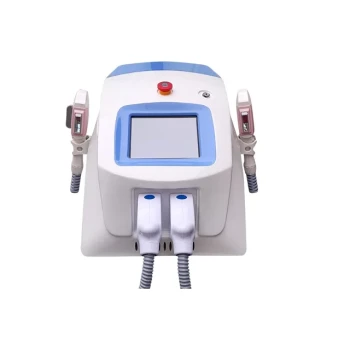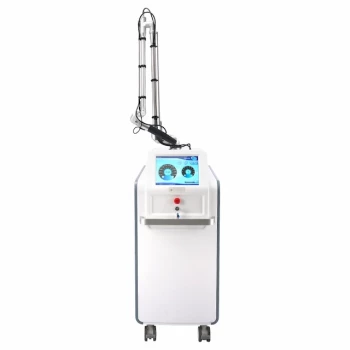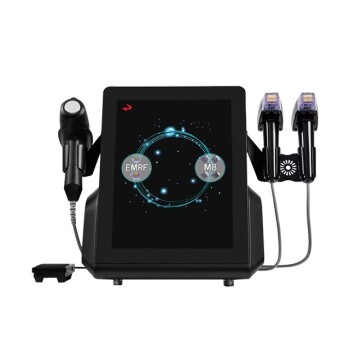In short, the hair is pushed out by your skin over one to three weeks. After an Intense Pulsed Light (IPL) treatment, the targeted hair follicle is damaged by heat. This process detaches the hair from its root, and your body then naturally expels it, which can temporarily look like new hair growth before it sheds completely.
The key to understanding the post-IPL process is realizing that what appears to be regrowth is actually the final stage of removal. The body is simply pushing out the dead hair shaft, which is a definitive sign the treatment was effective on that follicle.

The Mechanism: From Light Pulse to Hair Shedding
To understand what you see after a treatment, you first need to understand the process happening beneath the skin. The entire sequence is a controlled, biological response to the light energy.
Step 1: Targeting the Pigment
An IPL device emits a broad spectrum of light. This light is specifically absorbed by the melanin, which is the pigment that gives your hair its color.
This is why IPL is most effective on darker hair against lighter skin—the contrast allows the light energy to be absorbed by the hair and not the surrounding skin.
Step 2: Damaging the Follicle
When the melanin absorbs the light, that energy converts into heat. This heat travels down the hair shaft directly to the hair follicle, which is responsible for producing hair.
The goal of the treatment is for this heat to be sufficient to damage the key structures of the follicle, preventing it from growing new hair in the future.
Step 3: The "Extrusion" Phase
Once the follicle is damaged, it releases the hair shaft. For the next several days to a few weeks, your skin's natural renewal process will begin to push this disconnected hair upward and out of the pore.
This is the most misunderstood part of the process. It often looks and feels like stubble or new growth, but the hair is no longer attached to a living root.
Step 4: The Final Shed
Eventually, the dead hair is pushed out completely. This shedding often happens unnoticed in the shower or through gentle friction from clothing. The hairs will fall out effortlessly without any resistance.
Understanding the Trade-offs and Common Misconceptions
The period between the IPL session and the final shed can be confusing. Knowing what to expect and what not to do is critical for both peace of mind and the best possible results.
Mistaking Shedding for Regrowth
The most common point of confusion is thinking the treatment didn't work when you see what looks like new stubble. True regrowth from an undamaged follicle will feel rooted and firm. A shedding hair will fall out on its own or come out with a very gentle touch.
Expecting an Instant Result
The hair does not vaporize or disappear during the treatment. The process of shedding is gradual and relies on your body's natural skin-turnover cycle, which takes time. Patience during the 1-3 week shedding window is essential.
Not All Hairs Shed at Once
IPL is only effective on hairs in the anagen, or active growth, phase. At any given time, only a fraction of your hair is in this phase. Hairs in the resting or transitional phases will not be successfully treated. This is the fundamental reason why multiple sessions are required for significant, long-term hair reduction.
Making the Right Choice for Your Goal
Understanding the shedding process allows you to properly gauge the success of your treatment and assist the process correctly.
- If your primary focus is confirming the treatment is working: Look for the "stubble" to appear and then shed naturally within 1 to 3 weeks after your session.
- If your primary focus is aiding the shedding process: You can gently exfoliate the treated area a few days after the session (once any initial redness has subsided) to help the dead hairs come loose.
- If your primary focus is achieving long-term results: Commit to the full series of recommended treatments to ensure you effectively target hairs as they cycle into their active growth phase.
Ultimately, observing the hair shed is the clearest confirmation that you are on the right path to smoother skin.
Summary Table:
| Stage | Timeline | What Happens |
|---|---|---|
| Treatment | During Session | Light energy is absorbed by hair pigment, damaging the follicle. |
| Extrusion | 1-3 Weeks Post-Treatment | The body pushes the detached, dead hair shaft out of the pore. |
| Final Shed | End of Extrusion Phase | The hair falls out effortlessly, confirming the follicle is disabled. |
Ready to achieve professional, long-term hair reduction for your clients?
BELIS specializes in professional medical aesthetic equipment, providing powerful and reliable IPL systems for medical aesthetics clinics and premium beauty salons. Our technology ensures effective treatments and superior client results.
Contact our experts today to discover how our IPL devices can enhance your service offerings and grow your business.
Visual Guide

Related Products
- IPL SHR Hair Removal Machine for Permanent Hair Removal
- Clinic Use IPL and SHR Hair Removal Machine with Nd Yag Laser Tattoo Removal
- Clinic Diode Laser Hair Removal Machine with SHR and Trilaser Technology
- Diode Laser SHR Trilaser Hair Removal Machine for Clinic Use
- Diode Tri Laser Hair Removal Machine for Clinic Use
People Also Ask
- What are the negative effects of IPL? Understanding Risks for Safe Treatment
- Can IPL be used on all skin types? Understanding Risks for Darker Skin Tones
- Does IPL hair removal really work? Unlock Long-Term Hair Reduction with Science
- What is intense pulsed light good for? A Versatile Solution for Sun Spots, Redness, and Hair
- What should I look for in an IPL machine? Key Features for Effective Hair Removal



















